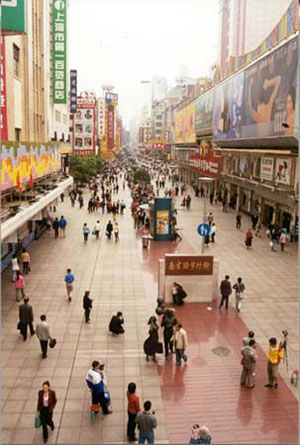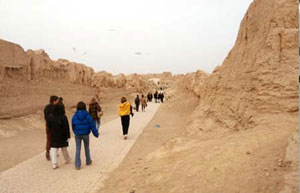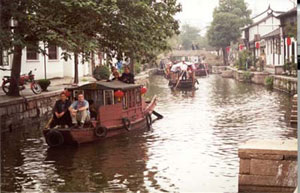 |
|
|
|
|
|
|
|
|
|
|
|
|
|
|
|
|
|
|
|
|
|
|
|
|
|
|
 |
 |
|
|
|
|
|
|
|
|
|
|
|
|

|
China
The Silk Road The last time we visited Shanghai, we arrived on a misty morning aboard the cruise ship Pearl, which had sailed up the Huangpujiang Estuary of the East China Sea. Our ship berthed on the Huangpu River, just a short walk from the celebrated Peace Hotel where the city’s most famous two streets meet: The Bund, which runs parallel to the water and Nanjing Road, an elegant shopping concourse. That day it seemed as if half the boats in the world were anchored or moving along the river. Now, five years later we reached the same destination on Air China from San Francisco and landed at Shanghai’s super-modern Pudong airport, completed only two years ago, to begin a journey across China on the Silk Road.
When we entered the city, much of it seemed familar. The Bund is an overwhelming landmark, a broad avenue lined with a row of large 19th-century European-style commercial buildings facing the Huangpu River, but separated from it by Huanbgpu Park, a recently built long promenade hugging the riverbank. These impressive old buildings are an architectural testimonial to the endurance of European imperialism in China, when Western nations forcibly established trading centers in Shanghai. One delightful change since our last trip was that two miles of Nanjing Road had been converted into a pedestrian mall, providing a stretch of shops, restaurants and hotels with no traffic and less crowding and noise than before. Many grand department stores line the mall as well as newer trademarks of Western culture like McDonalds and KFC. Shanghai, a major center of business and fashion, has much of the bustle of other great metropolises. The stylishly dressed locals are enamored of cell phones and many more pedestrians use them while strolling than in New York. As is usual with cruise ships, our previous stay was short, but now we had time to wander and could explore the city more thoroughly in visits to Old Town, the temples and the eponymous museum detailing the city’s history. The Yu Yuan is a beautifully landscaped two- and one-half acre garden, which seems larger because of its ingenious design, zigzag layout of pavilions, halls, towers, ponds, bridges and 30 scenic spots. We even scheduled an excursion to a suburb, the ancient village of Zhujiajiao, which is like a Chinese Venice. Small wooden boats move people and goods along the canals. The architecture is Ming and Qing and the old stone streets are lined with antique and gift shops. The 500-year-old stone bridges crossing the canals add a medieval touch. Then we were on our way traveling the Silk Road, the ancient route that tied Asia and China together. The Ocean Silk Road opened in the 2nd century BC and was used primarily for trading silks until the 15th century when its importance declined due to maritime competition. Although the road is not as prosperous as it once was, it is still historically and culturally significant. The great famed city of Xian, the most eastern point of the Road, is where most tours begin. Xian became the capital of China when Quin Shi Huang, 221-206 BC, named himself the first emperor after subjugating all the provinces of China under his rule. Quin commissioned the colossal terra cotta army, which was completely buried until some peasants, who in 1974 were digging wells, discovered it. Since that time archeologists have excavated and restored about 3,000 terra cotta figures out of an estimated 8,000. After Quin’s death the soldiers of a local warlord ransacked his underground army, probably designed to be available to him in the afterlife. They stole many of the weapons, smashed the statues and burned the wooden roof built to protect the terra cotta figures. Presumably this was done so that the army could not reappear in the next world to fight for Quin once more. The deplorable condition of the site has placed a tremendous burden on the restorers who were charged with reassembling everything. The Chinese claim that the excavation is the eighth wonder of the world. We tend to agree. It is an overwhelming experience to see these more than two thousand-year-old exquisite statues of warriors, horses and chariots.
Xian’s importance goes beyond its ancient relics. The city is believed to have been occupied as far back as 6,000 years. It was the capital of China on and off for 11 dynasties and 2,000 years. The magnificent walls from the Ming Period, built in 1374-1379, are the longest and best preserved city walls in China. Other prominent landmarks include the Big Wild Goose Pagoda, completed in 652 to honor Emperor Gao Zong and the Small Wild Goose Pagoda, built in 684 by Gao Zong to honor his mother. Principal sites, the Drum Tower and the Bell Tower, were constructed in 1370 and 1384 respectively. The next stop was Dunhuang, a charming Chinese city with a populace of just 10,000. Formerly it was a major center on the old Silk Road because the road west of it splits into two forks. From that juncture caravans could travel a northern or southern route. Dunhuang was a major point of entry for Buddhist ideas from India. Beginning in 366 monks carved hundreds of caves out of the hills and filled these caves with Buddhist wall paintings and sculptures. Known as the Mogao Ku Caves or Grottoes, they comprise the largest and best-preserved Buddhist art treasury in the world. Dunhuang is very near the Gobi Desert and one of the most exciting activities of a visit here is to ride a camel in the ocean of pure sand that is the desert, just as the silk caravans did hundreds of years ago. While the camels pause to rest, daring tourists can climb to the top of the tall dunes and slide down on small wooden sleds. The last stop was Urumqi in the far northwest of China, near Kirgizstan, once a part of the former Soviet Union and now an industrial city of over a million people. It is the capital of the Xinjiang Uygur Autonomous Region, the largest of the provinces and autonomous regions of China. The city includes 13 ethnic groups and boasts that it is farther from the sea than any other city in the world. It is also a center of the Muslim religion, which was introduced in the 8th century in China.
Urumqi is less interesting as an ancient center than the other cities along the way. But, there are some worthwhile excursions in the environs. Sixty miles east of Urumqi is Heavenly Lake, high on the slope of Mt. Tianshan and supplied by glacial water. To the south of Urumqi is another Silk Road center, Turpan, said to be the second lowest city below sea level in the world. Twenty-five miles away are the ruins of Gaochang, a city founded before Christ. In the 9th century a tribe of Uigurs, who look like a cross between Turks and Mongolians, established a kingdom here, but abandoned it by the end of the 13th century. The walls and buildings in Gaochang had been made of compressed clay and have been worn away by the elements. The street plan and the remains of a temple can be observed, but since the people who lived there left no records very little is known about them or their history. Thus ended our exploration of the famous Chinese Silk Road. The last stop on the way home was Beijing. We had seen all the city’s major attractions on our earlier trip except the newest one—the tour of the Houtongs, the streets of the old city, by pedicab. Houtongs are narrow passageways between the many quadrangles of housing in the ancient districts. They occupy about a third of Beijing, but are inhabited by about half its population. The day tour gives fresh insight into how the common people live. You also see the Drum Tower, built in Kubla Khan’s time, 1272, and the Bell Tower going back to 1420, as well as Shishahai Lake and Prince Gong’s Mansion with over 1,000 rooms and a huge garden attached to it. The changes in Beijing are monumental—impressive new buildings, grand hotels and brightly lit boulevards. Fortunately in China, new construction does not always mean discarding the old and many of the ancient treasures are well preserved for the visitor’s pleasure. One caveat, skip the large, crowded, well-known Qianmen Quanjude Roast Duck Restaurant. Your local Cantonese greasy spoon has better food. For brochures on Silk Road Tours, visit or contact the China National Tourist Offices. China National Tourist Office, 350 Fifth Avenue, New York, NY 10118. Tel. 212-760-8218 and 600 West Broadway, Glendale, CA 91204. Tel. 818-545-7507. www.cnto.org Spring 2001 |
||||||||


